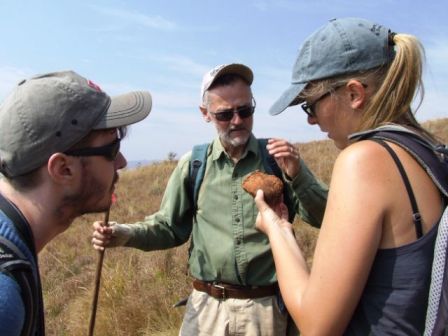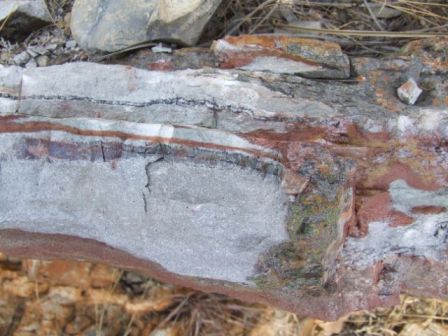
Prof Christoph Heubeck from the Geology Department of the Free University of Berlin with Masters Degree student Henry Nordhauss (left) and Doctorate degree student Nadja Drabon (right) from Stanford University discussing a volcanic specimen. Henry will analyze the depositional environment of the spherule bed and Nadja will do the geochemical analysis of the specimens collected.

Now you see it, now you don’t: This piece of rock contains tiny round grains that tell the story of a huge meteorite impact that took place about 3.3 billion years ago.
It is an approximately 300 mm thick spherule bed, cropping out along roughly 25 meters. Simply put, spherules are round grains that originated from liquid melt droplets that rained back to Earth after a meteorite impact. The over- and underlying chert rock in which this spherule bed is found dates back to about 3.3 billion years when the surface of the Earth was little more than huge shield-like volcanoes surrounded by silica rich oceans. Scientists say the planet did not have an ozone layer back then, allowing plenty of harmful UV-radiation to reach the surface. The sun’s light, however, was weak; there was little light and the atmosphere was a humid, thick cocktail of noxious greenhouse gases with very little, if any, free oxygen.
Considering that the depositional layer caused by the meteorite that killed the dinosaurs 65 million years ago is nowhere more than 3 mm thick, this 300 mm thick spherule bed gives an idea of how big this impact event must have been. But that is not the only reason why geologists are excited. What makes this spherule bed special is the purity of the material because it’s here that spherules rained into a deep ocean and were deposited in quiet, deep water. And it is also one of the very few spherule beds discovered north of the R40 Bulembu road.
“When small meteorites hit the Earth, they get slowed down by the atmosphere, plummet and dig into the ground and sometimes people find them. But large meteorites have such a large momentum that their kinetic energy converts into thermal energy upon impact. That is, they liquefy and vaporize upon impact, together with a large part of the target rock . Whatever the volume, imagine meteorites arriving on Earth with a velocity of between 11 and 72 kilometer per second, which is the common velocity for interstellar objects within our planetary system.
The Earth’s atmosphere is about 100 km thick and the meteorites pass through it within a second or two. They essentially punch a hole in the atmosphere, forming a tunnel of extremely low pressure behind them as the air did not have time to fill in that path. Add to that the tremendous heat that sucks up the rock vapor into the air and the rebound effect from the compressed target rock. As a result, very large volumes of molten and liquefied rock are injected into the stratosphere to heights of tens to hundreds of kilometers,” said Sedimentary Geology Professor Christoph Heubeck from the Free University of Berlin, Germany, who, together with postgraduate students, is researching the spherule bed and its surroundings.
“We think that more than 80 percent of the rock here consists of the target rock and less than 20 percent of the material of the impactor. Geochemical analysis of the trace elements in other spherule beds in the Barberton Mountainland found isotopes of Chromium 53 that we known exist only outside of Earth. We also found high concentrations of Iridium which is a heavy metal that is concentrated in the Earth’s core. However, Iridium is also found in meteorites, so both these geochemical indicators show that the material here has a bit of an extraterrestrial component.”
The droplets that had been ejected into the atmosphere due to the impact were distributed around the planet in orbits from where they rained back down. Some fell into shallow water and were reworked by tsunamis, waves and currents. Others, like the ones being studied here, fell in deep water and were preserved pristinely with only very little contamination from other material or reworking.
“The tsunamis triggered by meteorite impacts had the potential to travel around the young Earth several times leading to repeated reworking of the spherule beds. That’s why this location in which reworking and mixing is low is particularly valuable. To estimate water depth, slope, the processes that determined the “normal” situation at this place, and the sequence of events related to the impact, we need to look at the rock layers above and below the spherule bed. An additional reason that we are interested in the effects of meteorite impacts is that impacts even earlier in Earth history were even larger. Their kinetic energy was so large that they probably heated the oceans by a considerable number of degrees, briefly bringing to boil the ocean’s surface, thereby effectively sterilizing the Earth. This means that meteorite impacts in the early Earth’s history not only had a profound impact on the formation of sediments and tectonics but also on life and the evolution of early microbial communities,” said Prof Heubeck.
“About 40 meters from the spherule bed we have discovered a volcanic unit which may contain zircons that can be dated. This age will hopefully give us a good estimate of the age of the spherule bed.” Free University of Berlin Masters degree student Henry Nordhauss will analyze the depositional environment of the spherule bed. He will survey the strata meter by meter and document their composition and particular sedimentary structures because each rock contains information such as how large the currents may have been back then, how deep the sediments were in which these spherules fell and if there was any material that was reworked.
It is nearly impossible to imagine that the clear remnants of an event that took place 3.3 billion years ago have survived in the mountains till now. But it is exactly this kind of rock preservation that draws scientists back to the Barberton greenstone belt year after year.

Mark Schormann says:
Very cool – will have to try and take a look next time there. I wonder if someone could show us where it is?
editormountainlands says:
We will have to make a plan sometime.